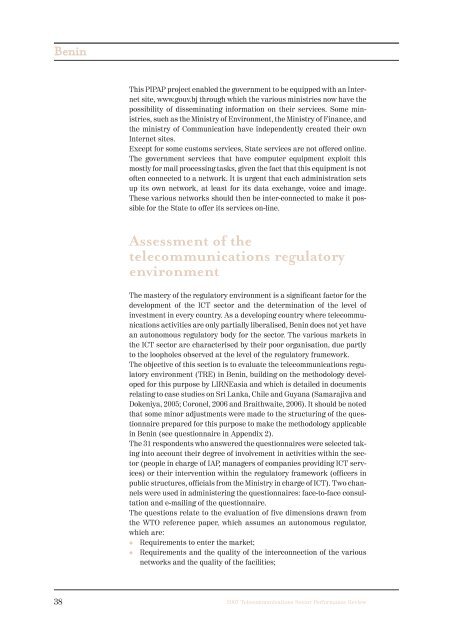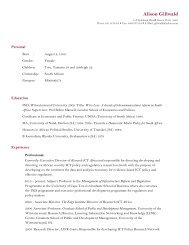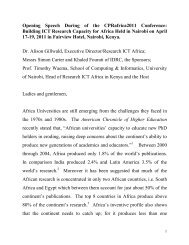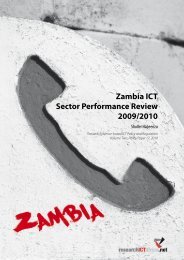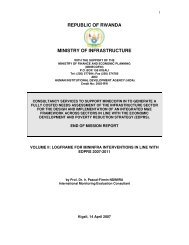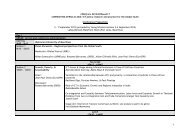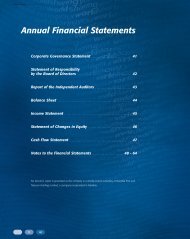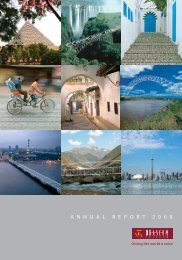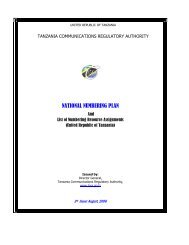Benin Telecommunications Sector Performance Review 2007
Benin Telecommunications Sector Performance Review 2007
Benin Telecommunications Sector Performance Review 2007
Create successful ePaper yourself
Turn your PDF publications into a flip-book with our unique Google optimized e-Paper software.
<strong>Benin</strong><br />
This PIPAP project enabled the government to be equipped with an Internet<br />
site, www.gouv.bj through which the various ministries now have the<br />
possibility of disseminating information on their services. Some ministries,<br />
such as the Ministry of Environment, the Ministry of Finance, and<br />
the ministry of Communication have independently created their own<br />
Internet sites.<br />
Except for some customs services, State services are not offered online.<br />
The government services that have computer equipment exploit this<br />
mostly for mail processing tasks, given the fact that this equipment is not<br />
often connected to a network. It is urgent that each administration sets<br />
up its own network, at least for its data exchange, voice and image.<br />
These various networks should then be inter-connected to make it possible<br />
for the State to offer its services on-line.<br />
Assessment of the<br />
telecommunications regulatory<br />
environment<br />
The mastery of the regulatory environment is a significant factor for the<br />
development of the ICT sector and the determination of the level of<br />
investment in every country. As a developing country where telecommunications<br />
activities are only partially liberalised, <strong>Benin</strong> does not yet have<br />
an autonomous regulatory body for the sector. The various markets in<br />
the ICT sector are characterised by their poor organisation, due partly<br />
to the loopholes observed at the level of the regulatory framework.<br />
The objective of this section is to evaluate the telecommunications regulatory<br />
environment (TRE) in <strong>Benin</strong>, building on the methodology developed<br />
for this purpose by LIRNEasia and which is detailed in documents<br />
relating to case studies on Sri Lanka, Chile and Guyana (Samarajiva and<br />
Dokeniya, 2005; Coronel, 2006 and Braithwaite, 2006). It should be noted<br />
that some minor adjustments were made to the structuring of the questionnaire<br />
prepared for this purpose to make the methodology applicable<br />
in <strong>Benin</strong> (see questionnaire in Appendix 2).<br />
The 31 respondents who answered the questionnaires were selected taking<br />
into account their degree of involvement in activities within the sector<br />
(people in charge of IAP, managers of companies providing ICT services)<br />
or their intervention within the regulatory framework (officers in<br />
public structures, officials from the Ministry in charge of ICT). Two channels<br />
were used in administering the questionnaires: face-to-face consultation<br />
and e-mailing of the questionnaire.<br />
The questions relate to the evaluation of five dimensions drawn from<br />
the WTO reference paper, which assumes an autonomous regulator,<br />
which are:<br />
Requirements to enter the market;<br />
Requirements and the quality of the interconnection of the various<br />
networks and the quality of the facilities;<br />
38 <strong>2007</strong> <strong>Telecommunications</strong> <strong>Sector</strong> <strong>Performance</strong> <strong>Review</strong>


